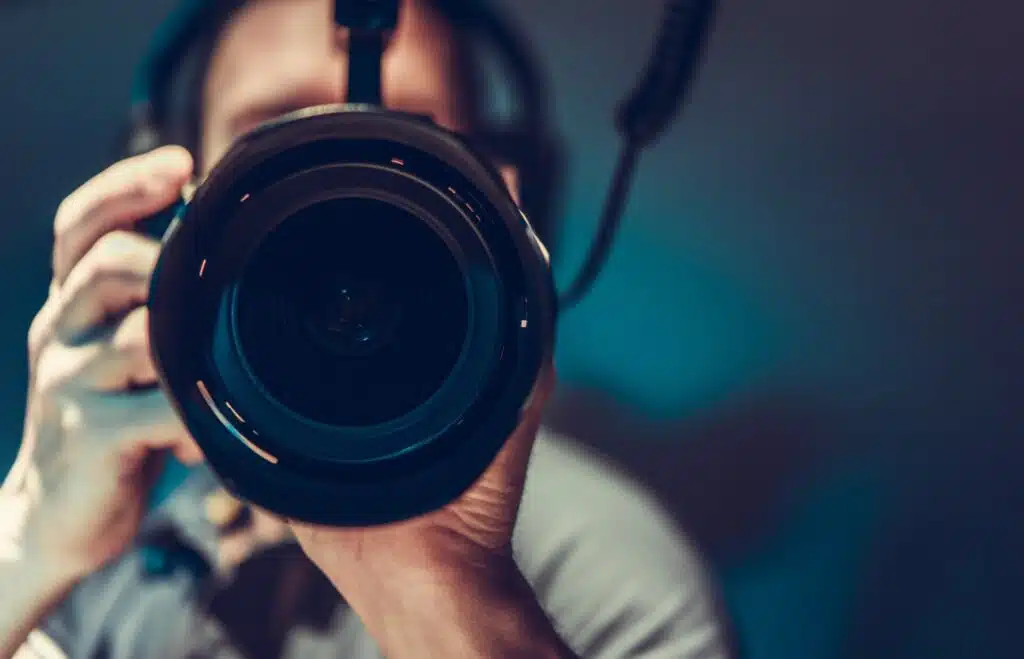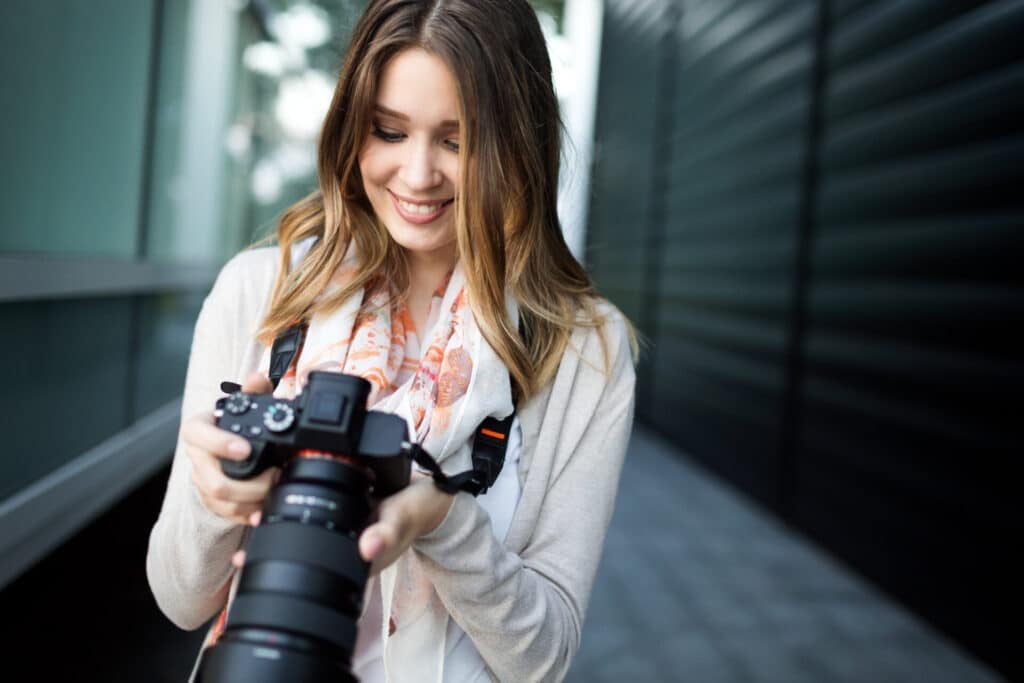Buying new gear at any experience level can be incredibly intimidating. Camera bodies, lenses, lighting, accessories…even gaff tape come in such wide varieties that it can be overwhelming to decide what’s going to be the right decision for you.
Let’s start with one of the larger purchases you’ll make, one that usually dictates what most of your other purchases will be: your camera body! There are so many options available, and if you don’t know what you’re looking for, you can easily be led into making a bad decision. This article won’t just rattle off a list of the newest cameras on the market. Instead, it will arm you with the knowledge you need to expertly navigate today’s camera market – and make an informed decision on which camera you should invest in and what to look for when buying a camera.
Full-frame or Crop Sensor
First, let’s cover one of the basics: full-frame or crop sensor? Of course, these aren’t the only two options available, but they’re the most common.
Full-frame cameras are sensors that mimic the size of 35mm film. Crop sensors vary between brands, have different names, and have various crop factors. Crop factors are represented as 1.5, 1.6, or 2.0.
I’m sorry to do this, but I’m going to have to ask you to do some math. I know, I know… if you liked math, you’d be studying engineering, not photography. Trust me; this is the only math you will ever have to do in photography (except for accounting for those windfall profits after you’ve equipped yourself with a state-of-the-art new camera). Picture a full-frame sensor. A crop sensor is simply a cropped version of that. A crop sensor with a 1.5x crop factor is 1.5x smaller than a full-frame sensor. As a result, an image captured on this crop sensor will be roughly 1.5x more “zoomed in” than the same image captured on a full-frame sensor.
Lenses also have crop sensors and full-frame versions. Therefore, it can be handy to know what the full-frame equivalent of a crop sensor lens is. To calculate this, simply multiply the focal length of the crop sensor lens by its crop factor. For example, a 50mm lens with a crop factor of 1.5 is the equivalent of a 75mm (50 x 1.5 = 75) lens on a full-frame camera.
Okay, we’re done with math for now! Some other considerations are resolution and price. Having a larger sensor means that there is usually more space for a higher pixel count. Although manufacturers can offer drastically different pixel counts on the same size sensor, high-megapixel counts will likely be found on larger sensors.
High resolution and small pixel sizes are only sometimes what you need, though. Pixels with a larger size tend to work better in low-light scenarios. They can take in a bit more light and often produce less noise. Think of it like this; a 40-megapixel camera has 40 million pixels, and a 20-megapixel has 20 million pixels. With a 40-megapixel camera, there are twice as many pixels to cause a noise. At the same time, the camera with 20 megapixels may give you a much cleaner image because the larger pixels take in more light.
Crop sensor cameras are often cheaper than full-frame cameras. They are a little smaller than a full-frame and thus are popular in scenarios where portability is essential. They tend to lack some of the features boasted by the more expensive full-frame camera, but this varies from model to model. Crop sensor cameras can be found at professional, prosumer, and consumer/entry-level price points.
DSLR or Mirrorless?
Another critical factor is whether a DSLR or mirrorless camera is a better option. A few years ago, this was way more of a debate than it is today. Then, DSLR cameras ruled the industry, and everyone wanted to have one. Almost every aspect of a DSLR was better than mirrorless at one point, but the lines are now blurred. DSLR means digital single lens reflex. They use a mirror to reflect the light coming through the lens into an optical viewfinder. The mirror flips up to expose the sensor and then returns to its original position, making the classic camera sound we all know, leaving you with a digital image you can review on a monitor. Mirrorless cameras are just as they sound, without a mirror. The light goes directly from the lens to the sensor. Mirrorless cameras are live-view cameras where you can see the changes you are making in real time on a screen or EVF (electronic viewfinder). In a mirrorless camera, all the autofocusing and processing happens in real-time – all in the same place. In a DSLR camera, there are often two autofocus sensors (if the DSLR has a live view). DSLR camera bodies are typically larger than mirrorless bodies since they have to house the mirror and allow its operation. Both mirrorless and DSLR offer full-frame and crop sensor options.
Now that you understand bodies and sensors, let’s move on to the most crucial consideration when buying a new camera: lens compatibility. If you only plan on using the kit lens that comes with the camera, this isn’t a big deal. However, lenses are typically where you will spend most of your money if you continue investing in photography. Lenses are not universal. They are designed with specific mounts that are compatible with different camera bodies. Luckily enough, lens adapters have become more accessible and have made most lenses interchangeable between brands. In addition, third-party lens manufacturers often offer the same lens with various mounts. Still, if you’ve invested thousands of dollars into one type of mount, it can be costly to switch to a different system.
Do Video Features Matter?
Even if your primary focus is photography, video features are another factor you should consider when comparing cameras. Speaking professionally, clients often shift focus about what kind of media they want to create, and the dominance of video in the modern media landscape is indisputable. It’s almost inevitable that you will need to shoot video in a professional capacity at some point. Most modern cameras can shoot video well, but some just do it better than others. Jumping back to resolution, higher megapixel cameras will often produce a sharper image. But, that still doesn’t mean a better shot. Most video-specific bodies have a lower megapixel count, with larger pixels to make their image more smooth and cinematic. Outputs and aftermarket support can also be important factors for you to consider. Some bodies have a mini HDMI out, but you may want a full-sized HDMI, so you don’t have to carry or find special cables if you need to send a live feed out. Different camera bodies have different output signals, as well. Some bodies will give you a “clean” output, which means your image is sent out, whereas others will just send whatever is on your screen. That would include any data, text, etc. So, if you’re sending it out to an external capture source, it would need a cleaner image. Bodies have different dynamic ranges and capture modes, such as RAW or LOG, which allows for a more remarkable ability to color grade and edit posts.
Is This a Hobby Or Do You Plan To Go Pro?
The final thing to consider when purchasing a camera is how you foresee your future in photography unfolding. If you see yourself as a hobbyist or simply want a camera to bring on trips and take pictures of your family, a lower-cost crop sensor camera may be ideal. If you want to turn photography into a career or a more serious hobby, investing in a higher-end camera with more functionality may make sense. If you think you’ll want to delve into video at some point, make sure you find a camera body that will allow you to do that.
Whatever camera you choose, always remember that people, not cameras, take photos. A camera is simply a tool that photographers use to capture images. Therefore, learning about lighting, composition, color, etc. will affect your photography more than a new camera body. Still, a great camera can remove some of the boundaries to capturing remarkable images.
Want to take your photography to the next level? F.I.R.S.T. Institute can help with that. F.I.R.S.T. offers hands-on courses designed to equip you with the knowledge and skills you’ll need to succeed in the photography industry. You can learn more about our photography program here.
Guest Author

Rainer Schuertzmann
Content Guru - Apex Creative Media






